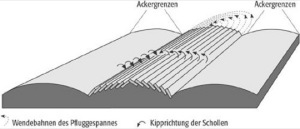Wölbacker
Description
In the Middle Ages ploughing began in the middle of the field, since turning ploughs didn't exist yet. Soil clumps are thrown into the middle of the field, so that the animals pulling the plough don't have to turn too frequently. Thus the fields were much longer than wide. Over time, slight domes of up to 1m height formed. The parallel domes were used for fruit, because they drain better. Potatoes, carrots, cabbage and beans often grow better on such uplifted terrain than on the flat landscape. Such ridge and furrow landscapes are historical landscapes and are protected where they still exist. But ridge and furrow landscapes are now proposed for e.g ecological gardening.








